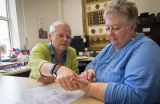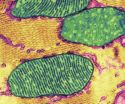(Press-News.org) COLUMBIA, Mo. – Researchers at the University of Missouri have proven that a compound initially developed as a cholesterol-fighting molecule not only halts the progression of breast cancer, but also can kill the cancerous cells.
"Cholesterol is a molecule found in all animal cells and serves as a structural component of cell membranes," said Salman Hyder, the Zalk Endowed Professor in Tumor Angiogenesis and professor of biomedical sciences in the College of Veterinary Medicine and the Dalton Cardiovascular Research Center at MU. "Because tumor cells grow rapidly they need to synthesize more cholesterol. Scientists working to cure breast cancer often seek out alternative targets that might slow or stop the progression of the disease, including the elimination of the cancerous cells. In our study, we targeted the production of cholesterol in cancer cells leading to death of breast cancer cells."
Previous studies suggest that 70 percent of breast cancers found in women are hormone dependent and can be treated with anti-hormone medicines such as tamoxifen. Although tumor cells may initially respond to therapies, most eventually develop resistance which causes breast cancer cells to grow and spread. Cholesterol also can contribute to the development of anti-hormone resistance because cholesterol is converted into hormones in tumor cells. Therefore, these cholesterol-forming pathways are attractive therapeutic targets for the treatment of breast cancer.
Using compounds initially developed by Roche Pharmaceuticals for the treatment of high cholesterol, which reduces cholesterol in a different manner than the widely used statins, Hyder and his team administered the molecule to human breast cancer cells. They found that the compound was effective in reducing human breast cancer cell growth and often caused cancer cell death. Most interestingly they found that the cholesterol lowering drug they tested destroyed an estrogen receptor, a protein which encourages the tumor cells to grow.
Equipped with this information, Hyder and the team tested the results in mice with breast cancer. Following injection of the compound, Hyder found that the molecule was effective at killing breast cancer cells by reducing the presence of estrogen receptors in tumor cells, Hyder said.
"The compound exhibited anti-tumor properties in both human samples, which were outside the body, and in samples that were administered by injection into the mice," Hyder said. "In both cases, the proteins that cause tumors to grow were eliminated, leading to more aggressive cell death."
Hyder believes that further clinical testing can lead to a drug that has the dual purpose of fighting high cholesterol and cancer.
INFORMATION:
Researchers involved with the study included Yayun Liang, research associate professor at Dalton Cardiovascular Research Center; Cynthia Besch-Williford, professor of veterinary pathobiology at MU; Benford Mafuvadze, post-doctoral fellow at Dalton Cardiovascular Research Center; Matthew Cook, pre-doctoral fellow in Biomedical Sciences; and Xiaoqin Zou, associate professor of physics and biochemistry and a researcher at the Dalton Cardiovascular Research Center. Johannes Aebi from Roche Pharmaceuticals also contributed to the research.
The study, "Cholesterol biosynthesis inhibitors as potent novel anti-cancer agents: suppression of hormone-dependent breast cancer by the oxidosqualene cyclase inhibitor RO 48-8071," was published in Breast Cancer Research and Treatment and was funded by a grant from the Department of Defense Breast Cancer Program and the National Institutes of Health.
Potential cholesterol lowering drug has breast cancer fighting capabilities
MU researcher suggest human clinical trials are needed for cholesterol-fighting compound
2014-06-17
ELSE PRESS RELEASES FROM THIS DATE:
Bats make social alliances that affect roosting behavior
2014-06-17
Depending on habitat availability, the endangered Indiana bat may be able to use its social connections to survive a certain amount of roost destruction, according to research by scientists at Virginia Tech and The Ohio State University.
Alexander Silvis of Lynchburg, Ohio, and Andrew Kniowski of Boones Mill, Virginia, both doctoral students in Virginia Tech's College of Natural Resources and Environment, made findings from Ohio State field studies highly visual by applying graphic and spatial approaches to the data.
"Social dynamics are important to bat roosting behavior," ...
Researchers map genomic differences in yellow fever, malaria mosquitoes
2014-06-17
Virginia Tech entomologists have developed a chromosome map for about half of the genome of the mosquito Aedes agypti, the major carrier of dengue fever and yellow fever.
With the map, researchers can compare the chromosome organization and evolution between this mosquito and the major carrier of malaria, the Anopheles gambiae mosquito, to find ways to prevent diseases.
"Despite looking somewhat similar, these mosquitoes diverged from each other about 150 million years ago. So, they are genetically further apart than humans and elephants," said Maria Sharakhova, a ...
Study reveals livestock gut microbes contributing to greenhouse gas emissions
2014-06-17
"Increased to levels unprecedented" is how the Intergovernmental Panel on Climate Change (IPCC) described the rise of carbon dioxide, methane and nitrous oxide emissions in their report on the physical science basis of climate change in 2013. According to the US Environmental Protection Agency (EPA), the atmospheric concentration of methane, a greenhouse gas some 28 times more potent than carbon dioxide has been steadily growing since the 18th century and has now increased by 50 percent compared to pre-industrial levels, exceeding 1,800 parts per billion.
The EPA attributes ...
'Vital signs' of teaching captured by quick, reliable in-class evaluation
2014-06-17
A 20-minute classroom assessment that is less subjective than traditional in-class evaluations by principals can reliably measure classroom instruction and predict student standardized test scores, a team of researchers researchers reported.
The assessment also provides immediate and meaningful feedback making it an important new tool for understanding and improving instructional quality, according to psychologists from the University of Rochester and the University of North Carolina at Chapel Hill.
"Education researchers broadly agree that teachers matter," explained ...
EHRA White Book 2014 highlights growing use of complex therapies for heart rhythm abnormalities
2014-06-17
Nice, France, 17 June 2014. The EHRA (European Heart Rhythm Association) White Book 2014 will be officially launched at the CARDIOSTIM EHRA EUROPACE 2014 congress which starts today in Nice, France.
The White Book reports on the current status of arrhythmia treatment in 49 of the 56 European Society of Cardiology (ESC) member countries for the year 2013. The new White Book is published in electronic format only and will be distributed on a USB stick as well as being available on the EHRA website. As a new feature, the USB stick contains complete data also from the six ...
Distracted minds still see blurred lines
2014-06-17
VIDEO:
Participants were asked to look at an image with moving sections blurred, while performing a cognitive 'n-back' task.
Click here for more information.
Montreal, June 17, 2014 — From animated ads on Main Street to downtown intersections packed with pedestrians, the eyes of urban drivers have much to see. But while city streets have become increasingly crowded with distractions, our ability to process visual information has remained unchanged for millions of years. ...
Pain pilot explores hand shiatsu treatment as sleep aid
2014-06-17
(Edmonton) There was a time, back in Nancy Cheyne's youth, when she combined the poise and grace of a ballerina with the daring and grit of a barrel racer. When she wasn't pursuing either of those pastimes, she bred sheepdogs, often spending hours on her feet grooming her furry friends at dog shows.
All that seems like a lifetime ago. After 15 years of living with chronic lower-back pain, Cheyne, 64, can't walk from the disabled parking stall to the elevator at work without stopping for a rest. She eats mostly junk food because it hurts too much to stand over the stove ...
Single dose reverses autism-like symptoms in mice
2014-06-17
In a further test of a novel theory that suggests autism is the consequence of abnormal cell communication, researchers at the University of California, San Diego School of Medicine report that an almost century-old drug approved for treating sleeping sickness also restores normal cellular signaling in a mouse model of autism, reversing symptoms of the neurological disorder in animals that were the human biological age equivalent of 30 years old.
The findings, published in the June 17, 2014 online issue of Translational Psychiatry, follow up on similar research published ...
Breast cancer diagnosis, mammography improved by considering patient risk: INFORMS paper
2014-06-17
A new approach to examining mammograms that takes into account a woman's health risk profile would reduce the number of cancer instances missed and also cut the number of false positives, according to a paper being presented at a conference of the Institute for Operations Research and the Management Sciences (INFORMS).
Mehmet U.S. Ayvaci of the University of Texas Dallas will present his research group's findings about the role of risk profiling in the interpretation of mammograms at Advances in Decision Analysis, a conference sponsored by the INFORMS Decision Analysis ...
Boost for dopamine packaging protects brain in Parkinson's model
2014-06-17
Researchers from Emory's Rollins School of Public Health discovered that an increase in the protein that helps store dopamine, a critical brain chemical, led to enhanced dopamine neurotransmission and protection from a Parkinson's disease-related neurotoxin in mice.
Dopamine and related neurotransmitters are stored in small storage packages called vesicles by the vesicular monoamine transporter (VMAT2). When released from these packages dopamine can help regulate movement, pleasure, and emotional response. Low dopamine levels are associated with neurodegenerative diseases ...
LAST 30 PRESS RELEASES:
Making lighter work of calculating fluid and heat flow
Normalizing blood sugar can halve heart attack risk
Lowering blood sugar cuts heart attack risk in people with prediabetes
Study links genetic variants to risk of blinding eye disease in premature infants
Non-opioid ‘pain sponge’ therapy halts cartilage degeneration and relieves chronic pain
AI can pick up cultural values by mimicking how kids learn
China’s ecological redlines offer fast track to 30 x 30 global conservation goal
Invisible indoor threats: emerging household contaminants and their growing risks to human health
Adding antibody treatment to chemo boosts outcomes for children with rare cancer
Germline pathogenic variants among women without a history of breast cancer
Tanning beds triple melanoma risk, potentially causing broad DNA damage
Unique bond identified as key to viral infection speed
Indoor tanning makes youthful skin much older on a genetic level
Mouse model sheds new light on the causes and potential solutions to human GI problems linked to muscular dystrophy
The Journal of Nuclear Medicine ahead-of-print tip sheet: December 12, 2025
Smarter tools for peering into the microscopic world
Applications open for funding to conduct research in the Kinsey Institute archives
Global measure underestimates the severity of food insecurity
Child survivors of critical illness are missing out on timely follow up care
Risk-based vs annual breast cancer screening / the WISDOM randomized clinical trial
University of Toronto launches Electric Vehicle Innovation Ontario to accelerate advanced EV technologies and build Canada’s innovation advantage
Early relapse predicts poor outcomes in aggressive blood cancer
American College of Lifestyle Medicine applauds two CMS models aligned with lifestyle medicine practice and reimbursement
Clinical trial finds cannabis use not a barrier to quitting nicotine vaping
Supplemental nutrition assistance program policies and food insecurity
Switching immune cells to “night mode” could limit damage after a heart attack, study suggests
URI-based Global RIghts Project report spotlights continued troubling trends in worldwide inhumane treatment
Neutrophils are less aggressive at night, explaining why nighttime heart attacks cause less damage than daytime events
Menopausal hormone therapy may not pose breast cancer risk for women with BRCA mutations
Mobile health tool may improve quality of life for adolescent and young adult breast cancer survivors
[Press-News.org] Potential cholesterol lowering drug has breast cancer fighting capabilitiesMU researcher suggest human clinical trials are needed for cholesterol-fighting compound




